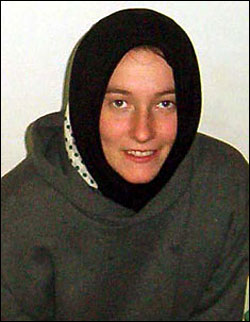On Sunday, March 16, Rachel Corrie, a 23-year-old senior at the Evergreen State College in Olympia, was killed by Israeli soldiers in the Rafah Refugee Camp in the Gaza Strip. Corrie was run overand run over again, when the army bulldozer backed up over heras she tried to prevent soldiers from demolishing a Palestinian home in the camp.
She was in the Gaza Strip as a volunteer with the International Solidarity Movement (ISM), among the most prominent of several nonviolent groups that in the last year have been bringing international activistsprimarily Americans and Europeansto work as peacekeepers: witnessing Israeli treatment of Palestinians; trying to provide assistance to Palestinian civilians wanting accompaniment as a form of protection against the Israelis; and bringing the stories of what they see back home to their own countries.
Not surprisingly, the circumstances of her death were disputed by the Israeli military and government, which claim that the bulldozers driver was unaware of Corrie. This is flatly denied by ISM volunteers who witnessed Corries death. In their version, Corrie talked with the driver only a few minutes before her death. Pictures from the scene show that she was wearing a fluorescent orange jacket.
A year ago, as Israel launched an unprecedented, brutal military offensive against Palestinian civilians in cities and camps throughout the West Bank, I interviewed one such activist, New Yorker and former Seattle Weekly employee Kristen Schurr. Schurr vividly described the daily violence unfolding around, and occasionally at, her and her fellow internationals (See A Rumor of War, April 11). Talking on the phoneon a lazy, serene spring daywith a young woman being shot at with American-made bullets was just a bit surreal. These volunteers, more than anyone, know the risks.
The Israeli/Palestinian conflict has largely disappeared from American news reports since last years Easter offensive, but thats not because the violence has ended. Quite the opposite: It has become routine, with daily violence and humiliation inflicted upon many Palestinians, Palestinian deaths (often of children) almost every day, and periodic cycles of Palestinian suicide bombingsall, at least rhetorically, inflicted either to retaliate against the other side or prevent future violence.
The level of economic deprivation, house and crop destruction, shoot-to-kill curfews, restrictions on employment and movement, random arrests, beatings, torture, and worse inflicted by the Israelis has essentially become background noise for most Americans.
A few, however, have been intentionally putting themselves in harms way.
The logic behind programs like ISM, which was launched by the Palestinian Center for Rapprochement Between People in late 2001, is similar to that of the human shield programs in the past. As in many conflicts where the protagonists are averse to publicityespecially in AmericaIsraelis have often hesitated to inflict their usual levels of violence when there are Western witnesses. Israel itself has tacitly acknowledged the effectiveness of such programsin recent months, the Israel Defense Force has begun arresting the volunteers, and both deportations and refusal of entry into Israel (the only way, also, to get into Palestine) have also increased sharply.
Corries death was the first among the international volunteers. However, ISM volunteers and other advocates for Palestinians argue that such volunteers have likely prevented countless other deaths, either by defusing confrontations or by their mere presence dissuading Israeli soldiers or settler vigilantes from attacks on individuals or families.

Rachel Corrie shortly before her death.
(photo: International Solidarity Movement/Getty Images) |
Olympia and Seattle have both been hotbeds of recruitment for the ISM and similar programsat least a dozen mostly young activists from each city have gone to Palestine for two weeks or longer in the last year. The ISM approach, however, is much older. It has its current roots in the Central American conflicts of the 1980s, particularly the emergence then of Peace Brigades International, which saved countless lives by sending Americans (and, later, Europeans) to Guatemala and Nicaragua to live with and accompany leaders or ordinary citizens who believed themselves at risk for death-squad or contra violence. The sole death came from Washington state. Ben Linder, a Seattle native and UW grad, was assassinated in 1988 by U.S.-funded contras.
Linders death led to congressional hearings, an enormous funeral in Nicaragua attended by thenNicaraguan president Daniel Ortega, and a place as a legend among that eras Central American activists.
The parallels between Linder and Corrie are inexact. Corrie was in Gaza specifically to prevent violence; Linder was also volunteering in a war zone, but as an engineer to bring hydroelectric power to impoverished, war-torn villages. Linder had been in Nicaragua for several years, and he was, by all evidence, specifically targeted for death by the contras.
Programs like ISM are also beginning to generate permanent volunteerspeople who develop strong personal bonds with their hosts, or who, after viewing the poverty and violence in Palestine, cant or dont want to reacclimate to comfortable American life. There are now hundreds of Americans serving as nonviolent peacekeepers and witnesses in both Palestine and Iraq. Theyre putting their lives on the line for their beliefs, for the love of humanity, and because they feel a need to take responsibility for the actions of our government.
Several local ISM volunteers have already been back to Palestine multiple times. Schurr, who was on an initial two-week trip at this time last year, mused then that, I dont know that I want to come back.
She stayed for months. After a few weeks speaking in the U.S., she returned to Palestine a few months ago.
Shes still there.







